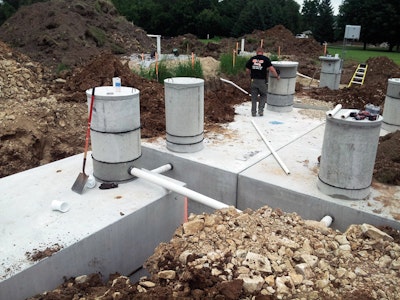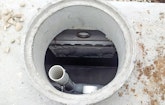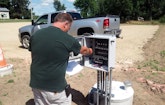
Interested in Pumps?
Get Pumps articles, news and videos right in your inbox! Sign up now.
Pumps + Get AlertsFriday night fish fries, a Wisconsin tradition, were a popular addition to the Aztalan Inn menu. Between 300 and 400 diners arrived those evenings, overwhelming the small sports bar and grill in Aztalan. The new owner then added a Wednesday night fish fry to divert some traffic.
Despite an indoor grease trap, exterior interceptor and twice-weekly pumping, grease migrated to the mound system, creating a 3-inch-thick biomat and subsequent ponding. Certified soil scientist and onsite designer Paul Hardy of Madison, Wis., planned a new mound system receiving effluent from Ecopod (Delta Environmental) aerobic treatment units.
“The modules are certified NSF/ANSI Standard 40 residential,” says maintenance provider Aaron Ausen. “The Department of Safety and Professional Services rescinded the permit because this was a commercial application and the staff had no protocol to follow.” A year passed before the agency approved the plans.
Site conditions
Soils are loess over glacial till with a loading rate of 0.4 gpd per square foot.
System components
Hardy designed the system to handle 2,565 gpd, which included a future restaurant expansion. Major components are:
- 1,000-gallon single-compartment concrete grease interceptor. Tanks made by Dalmaray Precast Concrete Products.
- Two existing 1,000-gallon dual-compartment concrete septic tanks converted to grease interceptors
- Existing 1,500-gallon dual-compartment concrete pump chamber converted to a septic tank with Orenco Biotube effluent filter
- 3,200-gallon equalization tank with duplex Goulds 0.4 hp submersible effluent pumps
- Two 4,300-gallon tanks with Ecopod E350-D modules
- 1,650-gallon dose tank with duplex alternating Goulds 1/3 hp submersible effluent pumps and Sim/Tech STF-100 effluent filter
- 45- by 122-foot-long mound with two cells
- Two custom control panels from Delta Environmental
System operation
Wastewater from the kitchen and lavatories empties into a 4-inch PVC lateral, flows by gravity through the grease interceptors to the septic tank, then to the equalization tank. Alternating pumps cycle every 15 minutes, sending 26.5 gallons in two minutes to dedicated fixed film treatment modules set in series.
Effluent gravity flows from the modules to the dose tank. Alternating pumps cycle four times a day, sending 241 gallons at 47.5 gpm through 2-inch force mains to two dedicated 8- by 107-foot-long gravel cells. A manifold distributes the dose to a cell’s two 105-foot-long laterals on 4-foot centers. Each 1.5-inch diameter pipe has 36 3/16-inch orifices spaced 36 inches apart. Both ends of the cells have 4-inch observation ports.
Installation
Dalmaray Precast engineers worked with Delta Environmental national sales representative Mike Catanzaro to design custom tanks for the modules. Catanzaro also designed stainless steel baffle weirs on the bioreactors to catch any residual bacteria before they reached the outlet line.
Jeff Levake of Levake Soil Testing in Lake Mills, Wis., installed the system, beginning with the mound in a field. Workers scarified the soil, laid 6 inches of septic gravel, built up the sand mound with 3 percent slope and laid the distribution lines. They covered the piping with 2 inches of stone, geotextile fabric and topsoil.
“Jeff did a wonderful job rounding off the mound and carving it to resemble a natural slope,” says Ausen. “He used leftover gravel to build an additional parking lot west of the mound.”
Meanwhile, Levake cut the lateral from the building, then installed the new grease interceptor ahead of the converted septic tanks. “Those tanks still drained to the old mound, so the pumper maintained his regular schedule throughout the installation,” says Ausen. “However, this was the only day the restaurant had to close.”
The second day, Levake dug 9- to 20-foot-wide holes for the treatment tanks and equalization tank. Using a Kobelco 115SR DZ hydraulic excavator, he removed 4 feet of topsoil, then hit an unexpected vein of dolomite bedrock. Switching to a rock ripper bucket, he chiseled down 6 feet. “This was the most difficult part of the installation,” says Ausen. “We had piles of bedrock everywhere.” The tanks were bedded on 3 inches of compacted gravel, then plumbed.
As the electrician prepared to wire the control panels, he discovered the power supply from the building was insufficient for the load. To accommodate the restaurant’s schedule, he worked 24 hours nonstop to upgrade the service and complete the job.
Filling the treatment tanks took two weeks, but the high-water alarms went off even before they were half full. “That confused us for several days,” says Ausen. “We finally figured out the exhausted electrician had wired the floats backward.”
Once the tanks were full, Ausen turned on the blowers, which have a timer. “We’re still in the six-month startup phase and have lots of adjustments to make,” he says. “After we fine-tune the system, the owner has the option of using the timer to turn off the blowers during slow times.
When the system reaches capacity in another two months, Ausen will draw effluent samples for BOD and TSS testing. “It’s not mandatory,” he says. “We want to know the treatment levels. Right now, everything looks very promising.”
Maintenance
Ausen holds the service contract. Twice a year, he’ll check the blowers, influent and effluent quality, and sludge level. Pumpouts occur when the level equals one-third of the tank’s volume. He will also inspect the cells every six months for the first two years, then annually.
“Aerobic treatment units occasionally fail due to lack of maintenance,” says Ausen. “Because of this system’s size and the high-strength waste it’s handling, I want to make sure everything is done properly.”








